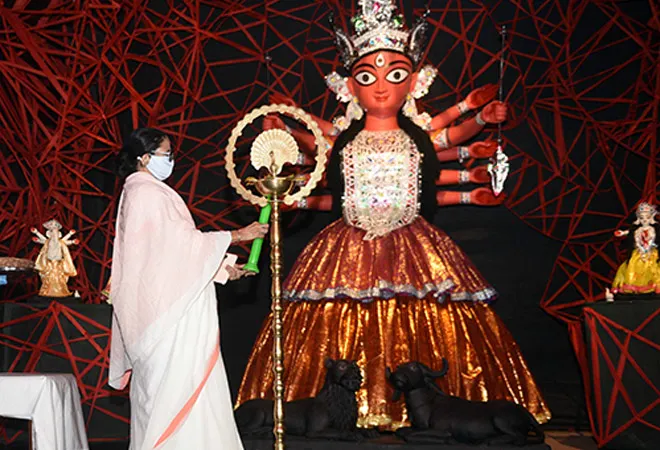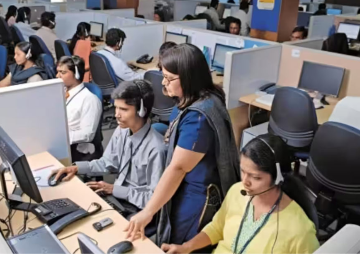
This year, Bengal’s trademark Durga Pujo festival (the worship of Hindu Mythology Goddess Durga) and the celebrations that run up to it are nothing short of a catch-22 situation. On one hand it cannot be denied that the sheer numbers involved in Bengal’s annual carnival makes it the largest street festival in the world – undoubtedly, the most economically and emotionally charged festival for the Bengali community worldwide. On the other hand, this crucial Hindu festival in this part of the world - with Kolkata being the eye of these major festivities - might lead to a steep rise in Covid-19 infections as an aftermath, according to experts.
Durga Pujo, which will be held between October 22 – 26 this year, has had its own journey from being a ‘Zamindari status symbol’ during the British era, to becoming a ‘nationalism project’ to awaken patriotic sentiments in India’s freedom struggle, to finally evolve into a contemporary ‘carnivalistic spirit’ for the masses. Relative to a lot of western religious festivals, Durga Pujo is a very exuberant form of celebration – cutting across religious communities and castes, and characterized by congregation of huge masses of people in the streets, pandals and even in the nearby tourist hotspots. Hypothetically, if the Covid-19 vaccine was in place, this festivity could have been an important measure to reset the ailing economy that could help fix the consumption demand problem in a limited local manner.
Previous experiences show that during peakhours, a single pandal could see tens of thousands of people. Even if the crowd is much less this year due to the fear of the virus and policing measures in place – even a tenth of the annual number could lead to a serious health crisis. This is in direct contrast to the social distancing guidelines that have been crucial since the beginning of the pandemic. People venturing out during the festival would also expose themselves to a host of infected surfaces. The vulnerability question is alarming, as a survey by NGO EkDesh in 18 Indian cities shows that most people are not wearing a face mask properly, or not wearing them at all - even though 90 percent are aware, only 44 percent of Indians are wearing a face mask.
There has been a steep rise in infections, a week after Mahalaya (an auspicious day in the Hindu lunar calendar that marks the beginning of the festive season) on September 17, indicated by the blue dotted line in the following figure. This is mostly because of crowding at marketplaces and increased mobility due to the associated logistics. On October 15,, Bengal recorded its highest single day spike of 3,720 new cases, and a day prior to that, the single day toll stood at an all-time high of 64 deaths.
Figure: Daily New Cases of COVID-19 in West Bengal (10th September – 16th October 2020)
 Source: Authors own, statistics from PRS Legislative Research
Source: Authors own, statistics from PRS Legislative Research
Although local trains are not expected to start before the festival, the resumption of this service during Durga Pujo could further facilitate the influx of people from rural areas into Kolkata, aggravating the problem. In fact, the Joint Forum of Doctors has issued a warning letter to the West Bengal Chief Minister that there could be a ‘tsunami of COVID infections’ after Durga Pujo - as was also seen in Kerala where the infection rate surged after its Onam festival in September.
The economics & politics
Although measuring the economic size of Durga Pujo seems to be a tough exercise, ASSOCHAM estimates suggest that the value could be pegged at approximately 1.12 trillion Rupees in 2018 (which is more than the entire nominal GDP of Mauritius), that contributes to about 10 percent of the state's GDP. Cancelling the festival would mean a huge loss to the state economy, along with the interlinked loss of livelihoods in numerous industries associated with the celebrations - that range from handicrafts to hospitality. Not to forget, the double whammy of Cyclone Amphan and the Covid-19 pandemic have jolted the state economy with economic losses estimated to the tune of 2.06 trillion Rupees (about 16.4 percent of the state GDP), only until the end of May 2020. Therefore, the burning question is - in an attempt to save the economic losses, can the state afford the additional investments in required health infrastructure? However, it might be important to note that the Mardi Gras of Kolkata cannot be viewed only through economic lenses. Are the celebrations entirely based out of a desperation for lost income and economic rebooting? As a colleague put it succinctly, Durga Pujo is like a cultural intoxication for the Bengali community, and hence, participation in the festivities doesn’t really follow any pattern of behavioral rationality - even if the cons outweigh the pros by huge margins.
With more than 1.1 million deaths worldwide and India racing to topple US in becoming the country with the largest total number of Covid-19 infections; it would be naïve to assume that there is no politics over the Durga Pujo dilemma. Since a large chunk of Trinamool Congress (TMC) critics accuse the party of minority appeasement, many believe that curbing the Durga Pujo celebrations would hurt the ruling party in the 2021 state elections. In one of the pandals, the Durga Idol was replaced by an idol of a migrant worker holding her baby - a few months back the TMC government had launched a scathing attack on its principal opponent, the BJP, for being unable to handle the migrant distress across the country. In another strategic move to connect with the masses, the Prime Minister is also expected to virtually address the live inaugural sessions this week at cultural centers and pandals across the state.
The Chief Minister has also doubled the financial assistance to Pujo Committees this year – a dole of 50,000 Rupees is given to each club. Although increasing government expenditure through various means may be the need of the hour to recover the pandemic-infected economy, Nobel laureate and economist Abhijit Banerjee suggests direct cash transfers to the poorer sections, who are severely affected by the pandemic.
For many Western countries, summer is a crucial time for a large number of important festivals. Many organizers have indeed found ingenious ways in which these events need not be cancelled. These ranged from - purpose-built pods with table service in a two-month long festival in England to American drive-throughs selling staples such as corndogs and funnel cakes. However, given the huge population and low budget this year, such social distancing measures may not be feasible in Indian festivals such as Durga Pujo.
The Government of West Bengal plans to undertake a series of measures for the festival, such as prohibition of the idol immersion carnival, deployment of additional civic volunteers to ensure social distancing and so on. The way forward is through strict minimization measures and crowd control techniques, which must be seriously undertaken. As the festive fervor grows in intensity, the question remains; could the celebrations not have waited for one year?
The views expressed above belong to the author(s). ORF research and analyses now available on Telegram! Click here to access our curated content — blogs, longforms and interviews.




 Source: Authors own, statistics from
Source: Authors own, statistics from  PREV
PREV


